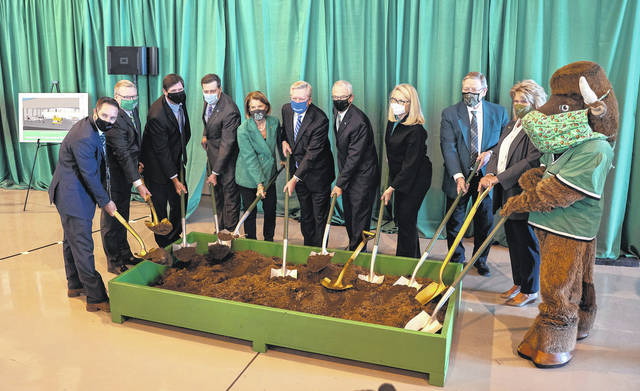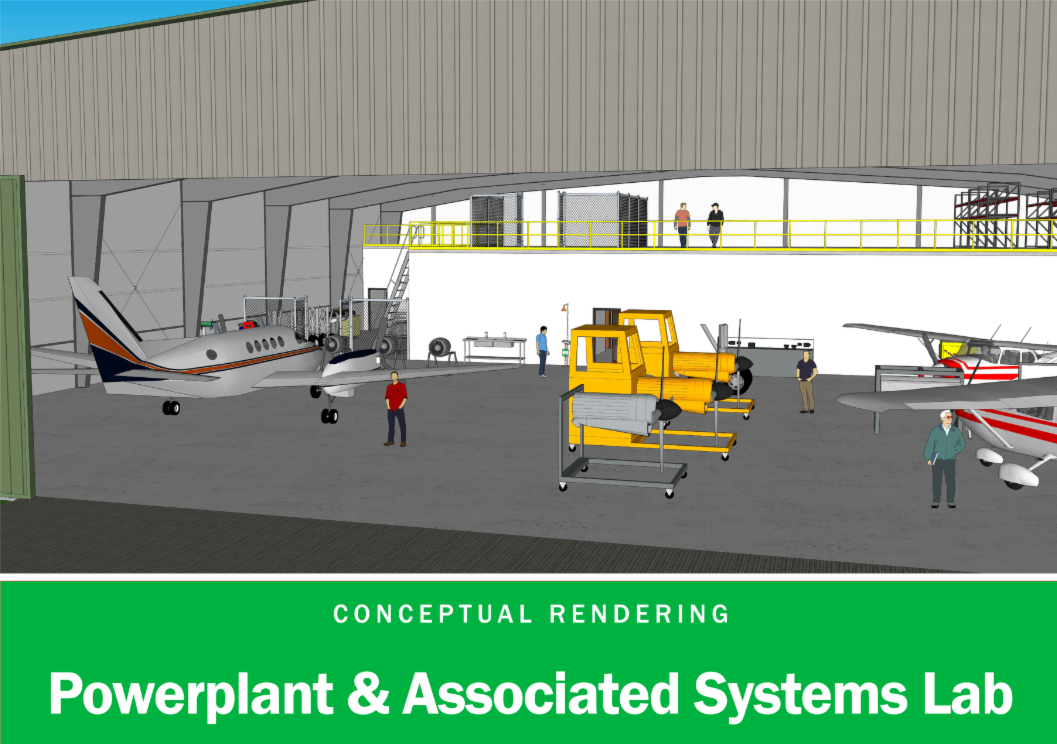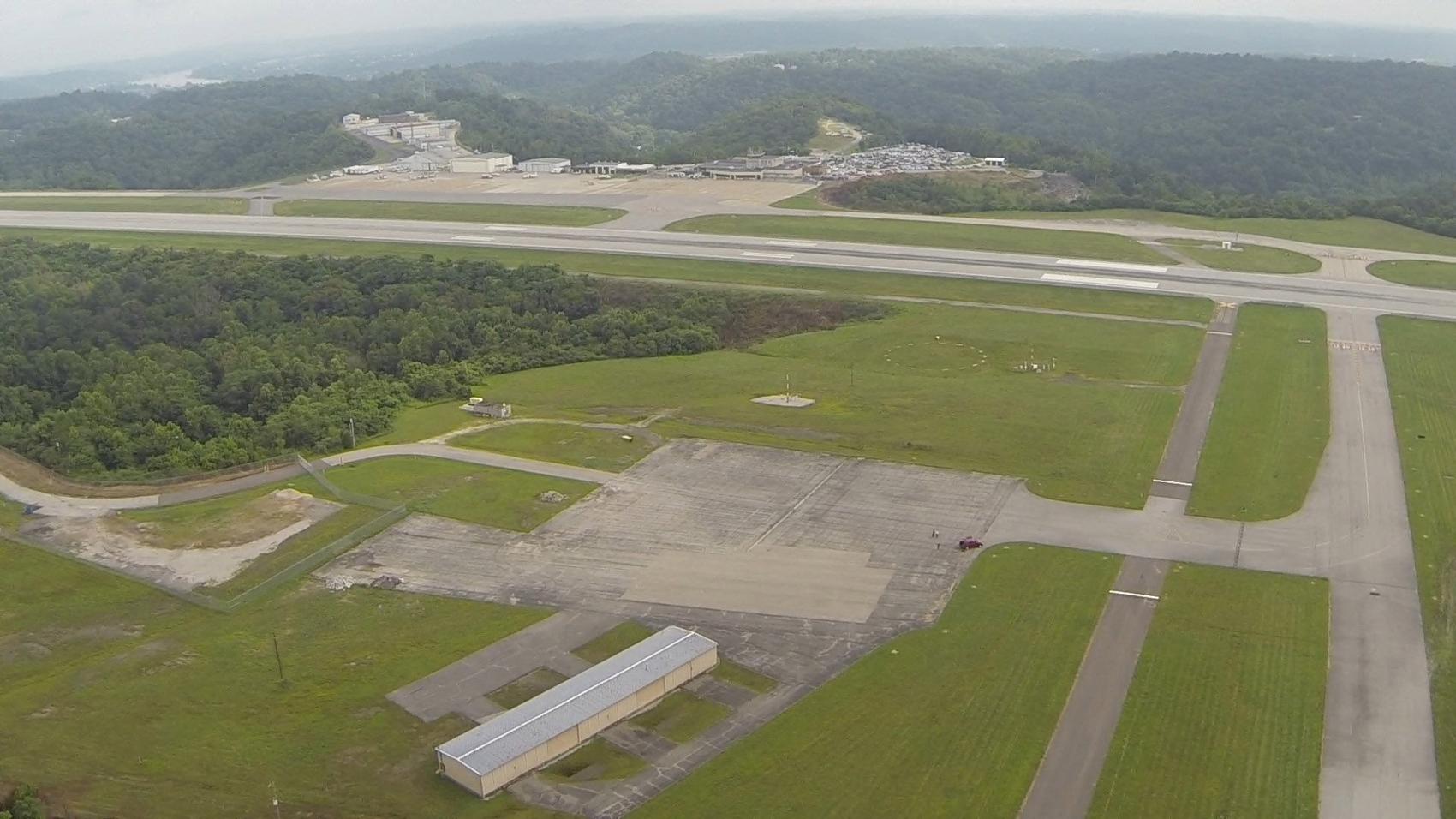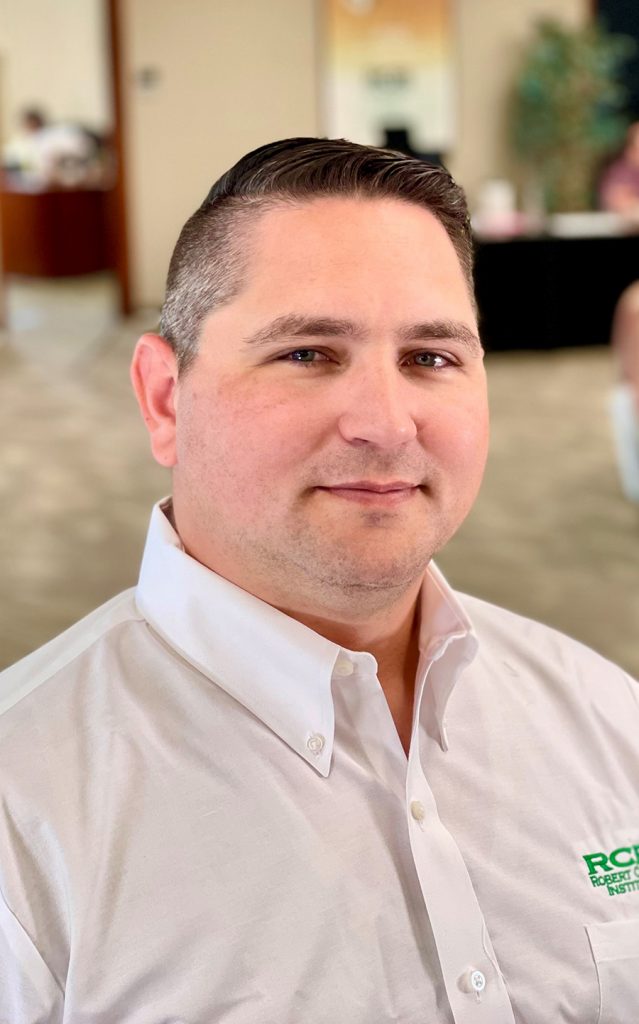MEDIA

Soaring to New Heights: Region Builds Aerospace Sector Through Aviation Training Program

A Major Step Forward for Aerospace Development
Earlier this spring, over 100 local, state and federal leaders gathered in a large hangar space off of Milton J. Ferguson Field at Huntington Tri-State Airport to attend Marshall University’s official groundbreaking for its new Aviation Maintenance Technology degree program and to celebrate a major step forward in growing the region’s aerospace and aviation industry. This new program, administered jointly through Marshall University and Mountwest Community and Technical College, will be housed in two newly renovated hangars at the airport and will allow students to earn their associates degree and the Federal Aviation Administration (FAA) Airframe and Powerplant (A&P) license that is required to become an aviation maintenance technician. The program offers residents in the region a career pathway to an in-demand industry sector with outstanding wage potential. It also provides the region with a clear marketable training asset for attracting new aviation investment to the area. The program launch is only the latest milestone reached after five years of collaboration and planning by multiple local economic development organizations, and various public and private sector partners committed to turning the greater-Huntington area and surrounding region into a destination for aerospace investment.
Why Aerospace?
Local economic development agencies around the tri-state began to evaluate aerospace as a target sector in 2016. At the time the domestic coal mining industry in West Virginia had gone into a dramatic decline, and economic developers throughout the region were eager to find new opportunities. Aerospace arose as a likely target industry sector for a number of reasons, but most notably because of the alignment of transferable skills from the region’s mining and primary metals industries to various aviation-related sectors.
The U.S. Aerospace industry is the largest in the world directly employing 500,000+ high skill and high wage positions in the U.S. More than 4,000 West Virginians work in this industry. These are in-demand career fields supporting high wages. Boeing estimates that 754,000 new aviation maintenance technicians will be needed by 2037. Median wage rates for these positions are more than $64,000 per year and $31.00 per hour. The Aerospace industry has the largest export trade surplus of any manufacturing industry in the United States, contributing $151 billion in export sales in 2018 and receiving nearly $22 billion in foreign direct investment.
Looking to capture some of this investment in the broader region, a core group of development agencies, including Huntington Area Development Council (HADCO), Ashland Alliance, One East Kentucky and Southern Ohio Port Authority, decided to invest in a strategic evaluation of the region’s readiness to attract aerospace and aviation investment.
Our “AEROready” Community
A consultant team was brought in to evaluate the region’s attractiveness for aerospace and aviation investment. Robert Ingram, Principal at Common Sense Economic Development, and Tucson Roberts, Principal at Tucson Atlantic Consulting, each have decades of experience in the aviation industry in the Gulf Shore Region. Their review of the Huntington area and its assets revealed that the region is in prime position to win new aviation and aerospace investment.
The Huntington area along with partners representing 12 counties in Southern Ohio and Eastern Kentucky were each independently evaluated and certified as AEROready communities. The consultants’ evaluation reviewed 14 key drivers of aerospace relocation and expansion projects, including an evaluation of existing aviation and aerospace industries within the region, the presence of specialized training and education institutions, airport access, existing workforce in several key skills groups, as well as quality of life factors.
Cabell and Wayne counties were evaluated highly on each AEROready metric, including a favorable review of the transferable skills groups within the surrounding labor shed. It was concluded that there was a very high density of many of the skills compatible for 74 essential industry-wide aerospace occupations such as machining, welding, structural metal fabricating, and engineering skills groups. It was also determined through this evaluation that many of the skills groups associated with the mining and manufacturing industries are easily transferable to aerospace and aviation manufacturing and maintenance; and, as those industries continue to shed employment, aerospace and aviation can help to replace the declining employment opportunities in these industries.

Appalachian Sky & RCBI Aero
Appalachian Sky was the natural progression of the AEROready Community assessment. American Electric Power funded this three-state initiative, with the goal of marketing the region’s collective assets for aerospace investment.
The Appalachian Sky Region, a three state, 14 county region mostly consisting of the Huntington-Ashland, WV-KY-OH Metro Area, has developed a strong collaborative presence over the years. As members of the Huntington Tri-State Airport, participating local economic development organizations work together often and frequently attend marketing and trade show events together, such as MRO Americas and National Business Aviation Association Annual Conference.
“Jointly marketing the region is key to targeting the large-scale employers we are hoping to attract to the area,” says Dave Lieving, President of HADCO and Board Chair of Huntington Tri-State Airport Authority. “Marketing the region’s assets together along with partners in Ohio and Kentucky gives us access to labor force metrics, and sites that we otherwise would not be promoting. When targeting a large industry like aerospace, regional collaboration is important.”
The Appalachian Sky region is marketed for its outstanding labor force, but also its proximity to several aviation geographic clusters. These include the I-75 Corridor between Columbus, Dayton, Cincinnati, and Lexington which is part of a federally designated aviation corridor called SOAR, and the Mid-Atlantic Aerospace Complex in Bridgeport, West Virginia which supports several large aerospace companies including Lockheed Martin, Aurora, Pratt & Whitney Engine Services and many others. The Appalachian Sky region is well positioned to serve these geographic industry clusters with downstream business services, logistics access, and parts manufacturing.

Another progression from the AEROready Community Assessment is the development of RCBI Aero, a federally funded program administered by the Robert C. Byrd Institute. If Appalachian Sky is focused on marketing the region for aerospace investment, RCBI AERO is perhaps more narrowly focused on delivering resources and value to existing companies in the region.
“One of the primary goals of RCBI Aero is to increase the footprint of aerospace development across the region by helping bring new aerospace products to market and providing the focused education and training that aerospace companies need to grow,” says James Smith, Director of RCBI Aero. “Through RCBI Aero, aerospace companies have access to more than $20 million in equipment and a skilled staff that boasts more than 750 years of combined manufacturing experience.”
Training is a major part of the program’s mission as well.
“RCBI’s Welding Technology and Machinist Technology/CNC programs train workers who are filling a pipeline of skilled talent for the aerospace industry. RCBI AERO offers customized training and quality management systems implementation – especially AS 9100 and other international quality standards – that aviation companies need so they can succeed and grow.”
While RCBI AERO is offering a training solution for one part of the aviation industry, Marshall University along with Mountwest Community and Technical College is providing another distinct solution and perhaps one of the key missing pieces for aerospace development in the region; an aviation maintenance technology program.
Training the Next Generation of Aviation Technicians
One gap listed in the AEROready Community Assessment is the lack of a specialized FAA Certified A&P training programs within an easy commute of Huntington. While there are other programs available in the region to provide skills training required for many aviation-related industries, the closest A&P training program is located in Wilmington, Ohio. The lack of an in-region aviation maintenance program, severely limits the prospect of attracting a maintenance, repair and overhaul (MRO) facility, a final assembly plant or many other aviation-related sectors to the area. So, following the recommendations of the report, as well as other industry analytics, officials at Marshall University determined that a set of aviation programs was necessary to fill these much-needed skills gaps in the region and set off in planning the establishment of two new programs: a new flight school in partnership with Yeager Airport in Charleston, WV, and an aviation maintenance technology (AMT) program in partnership with Huntington Tri-State Airport in Huntington, WV.
The launch of Marshall University’s AMT program has the potential to be a game changing development for the region. According to William Smith, Director of Learning and Development for Technical Operations at Delta Airlines, existing AMT programs inside the United States only have the capacity to meet about 65% of the industry’s current need for aviation mechanics. So, the aviation industry is starving for the type of talent that this program can provide a steady pipeline for; and with this program in place, Huntington becomes an attractive location for aviation-related industries needing to employ these individuals.
James Smith, Director of RCBI Aero and Interim Director of Aviation Technology and Maintenance at Marshall University is excited about the new opportunities the new program will bring. According to Smith, the program will officially launch in January of 2022, and “will eventually provide some of the most robust, multifaceted aviation maintenance education in the nation.”
The program will be rigorous and is designed to be completed in about 18 months, earning both an Associate of Applied Science as well as an opportunity to obtain an FAA A&P certification. According to Smith, “Students not only will attend focused lectures from industry-experienced instructors, they also will complete hands-on projects in jet engine maintenance, structural sheet metal, electrical systems, composite materials, hydraulic systems and other related topics. Our students also will have the opportunity to earn national certifications in precision measurement, electrical terminations, composites technology, and avionics.”
Students of this program will also benefit from the programs close partnerships with the Robert C. Byrd Institute, Toyota Motor Manufacturing West Virginia, and Delta Air Lines Technical Operations. The new AMT program joins 45 other such programs around the U.S. to earn a key endorsement from Delta. With Delta’s endorsement, Marshall’s new program will have access to training and curriculum development resources through Delta along with parts, tooling, and other hard assets necessary for the program’s success.
With the full support of the Huntington Tri-State Airport, governmental entities such as Appalachian Regional Commission and U.S Economic Development Agency, and the support of local agencies such as HADCO and Region II Planning and Development, the AMT program is on firm footing to set our region up for success.
“It’s graduates will help attract even more aviation companies to the region,” says James Smith, “because a skilled workforce is one of the main—if not the main—reason companies cite when looking to relocate or expand to a region.”

Landing the Next Project
A skilled labor force is key to driving aerospace investment, but another driver is availability of quality sites. One of the true hidden gems in the region is the Huntington Tri-State Aeroplex site; 95 acres of developable industrial grade property with direct access to the runway at Huntington Tri-State Airport, and all utilities on site.
“Such large acreage adjacent to an airport is rare in the West Virginia and East Kentucky Appalachian Region,” says Tucson Roberts, consultant and co-author of Huntington’s AEROready Community Assessment. “The site is an excellent location for a potential MRO operation or other aerospace industries that require airport services.”
The Tri-State Aeroplex has developed into one of the region’s most marketable sites. In 2018 the site earned the Quality Site designation through American Electric Power (AEP) and its subsidiary, Appalachian Power Co., for site readiness. The designation came as part of an independent review of the site AEP conducted with assistance from the engineering firm Burgess and Niple, who analyzed the site acreage, zoning, utilities, site access, environmental impacts, site restrictions, and other key factors.
In 2016, about $2.5 million in infrastructure improvements were completed on the site. These included adding several utilities such as sewer, fire water, potable water, and fiber.
Brent Brown, Director of the Tri-State Airport, believes the site can support major industry and is marketing the site accordingly.
According to Brown the site would be perfect for a large MRO facility, and then other businesses could spin off of that, “like an avionic shop, aircraft paint shop, and also room for many private hangars for aircraft storage. We are marketing the site with economic development leaders and groups in the Tri-State, like HADCO, that have the data and marketing tools needed to bring business, industry, and new jobs to this site."

Bringing it all Together
Through a combination of planning, state and local funding, public and private sector investment, and shear willpower, serious strides are beginning to be made in the development of the region’s aerospace sector. HADCO and its various partners are in the beginning stages of revamping its marketing initiatives through Appalachian Sky. AEP has been leading the formalization of the Appalachian Sky initiative. The organization was formally made public as a 501 c3 non-profit organization earlier this year. HADCO and its partners at the Ashland Alliance, OneEast Kentucky, and Lawrence County Economic Development Corporation have taken officer roles in the organization. The goal is to create a comprehensive marketing program which will benefit the region, allowing these organizations to collectively market the region for new investment. With the pandemic quickly falling behind us, the region is ready to move forward into a bright new horizon.
For more information on any of these programs, including how to access various training and technical resources related to aerospace, please reach out to James Smith, Director of RCBI Aero at jsmith@rcbi.org or you can contact Adam Phillips, Business Development Specialist at HADCO via phone at 304-525-1161 or via email at aphillips@hadco.org.

